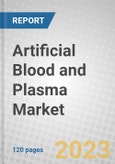The scope of this study encompasses an investigation of the global market for artificial blood, focusing on various important aspects of the market, such as research and development, clinical trial outcomes, approval status, and the potential commercial demand for artificial blood products. The report includes a discussion of artificial oxygen carrier products. The report analyzes each market segment and provides a forecast for six years. The current report analyzes the market's drivers, challenges, and opportunities. The report also covers market projections for 2028 and the market analysis for key market players. The report includes the company profiles of the key players with detailed information about their business segments, financials, product portfolios, and recent developments. The report also provides information on emerging technologies, the impact of COVID-19, product analysis, deals, and investment outlook.
The Report Includes:
- 41 tables
- An overview of the global markets for artificial blood
- Estimation of market size and analyses of global market trends, with data from 2020-2022, estimates for 2023, and projections of compound annual growth rates (CAGRs) through 2028
- Highlights of the market potential and characterization of artificial blood market by product, application, and region
- Examination of the key drivers and constraints that will shape the market and discussion on the upcoming market opportunities and areas of focus to forecast the market into various segments and sub-segments
- Coverage of recent advances, emerging technologies, and developments of the industry
- Evaluation of key industry acquisitions and strategic alliances and market share analysis of the leading suppliers of the industry
- Company profiles of major players within the industry, including Hemarina, VirTechBio, and NuvOx Pharma
Table of Contents
Executive Summary
The human body contains a vital fluid called blood, which delivers oxygen and nutrients to the body’s cells and carries waste products away from the cells in a gas exchange process. The artificial blood being developed is intended to satisfy some of the functions of biological blood, particularly in humans.
Currently, two fundamental approaches to artificial blood are being taken: perfluorocarbons and hemoglobin-based oxygen carriers.
Safe and timely access to blood transfusion is crucial for saving lives and enhancing health. Unfortunately, numerous patients needing transfusions face difficulty obtaining secure blood supplies promptly. Blood transfusions are done for several conditions, such as severe injury or trauma with significant blood loss, surgery, childbirth, anemia, cancer, kidney failures and others. The blood shortage and the risks and challenges associated with donor blood have led to the development of artificial blood. Notably, the potential market for artificial blood is very high, and estimated to be around $22.6 billion in 2028 and hence the market needs products which would cater to such high unmet need.
The research for finding a potential alternative for blood, has been ongoing for centuries, but the results have been disappointing. This is mainly because of the adverse reactions associated with the developed products. Because of this, these products have been terminated or discontinued during clinical development. The poor success rate of the products led to losses for the companies, because of which they have filed for bankruptcy or are out of business.
Recently, it has been observed that companies are focusing on developing products that would address the shortcomings of the failed or existing products in the pipeline. Some of these include the development of freeze-dried HBOCs, Erythromer (from Kalocyte) (which is based on nanocapsule technology), and biosynthetic red blood cells (producing red blood cells from stem cells), being developed by companies such as Erypharma and Red C Biotech. Researchers are also focusing on the development of artificial whole blood by combining three synthetic components: freeze-dried platelet surrogates, freeze-dried red blood cell surrogates, and freeze-dried plasma.
The artificial blood market was estimated to be $23.9 million in 2022 and is forecasted to grow at a compound annual growth rate (CAGR) of 9.2% to reach a value of $40.5 million through 2028. The market value is low because there are no approved products for artificial blood. Hemopure is the only marketed product for anemia and is approved in South Africa and Russia and used under an expanded access program in the U.S. Currently, the company doesn’t have the infrastructure and funds to produce the product and the company reported no revenue in 2021. In 2022, HemO2life from Hemarina was approved for use as an additive for kidney grafts in the European Union. There are no approved products for routine clinical use in the U.S., which is the primary market. A similar product for graft preservation is being developed by VirTechBio-OxyBridge-which is in development and anticipated to enter the U.S. market by 2026. There are companies with products in Phase II and Phase II/III development, but the products might not be approved in the forecast period or enter the market by 2028. However, future approvals will help cater to the high unmet need in the market.
Factors leading to the growth of the market are increasing demand for blood transfusions and risks and challenges associated with blood transfusions and shortage of blood supply. Factors such as low rate of approvals, product acceptance, and higher pricing act as barriers to the market. The market is dominated by startup and private biotech companies. Key players in the market include Hemarina, NuvOx Pharmaceuticals, VirTech Bio, and Prolong Pharmaceuticals.
Companies Mentioned
- Aurum Biosciences
- Erypharm
- Hemoglobin Oxygen Therapeutics LLC.
- Hemarina
- Kalocyte Inc.
- Nano Sanguis S.A
- Nuvox Pharma LLC.
- Prolong Pharmaceuticals, LLC
- Red C Biotech
- Virtech Bio
Table Information
| Report Attribute | Details |
|---|---|
| No. of Pages | 120 |
| Published | August 2023 |
| Forecast Period | 2023 - 2028 |
| Estimated Market Value ( USD | $ 26.1 Million |
| Forecasted Market Value ( USD | $ 40.5 Million |
| Compound Annual Growth Rate | 9.2% |
| Regions Covered | Global |
| No. of Companies Mentioned | 10 |









